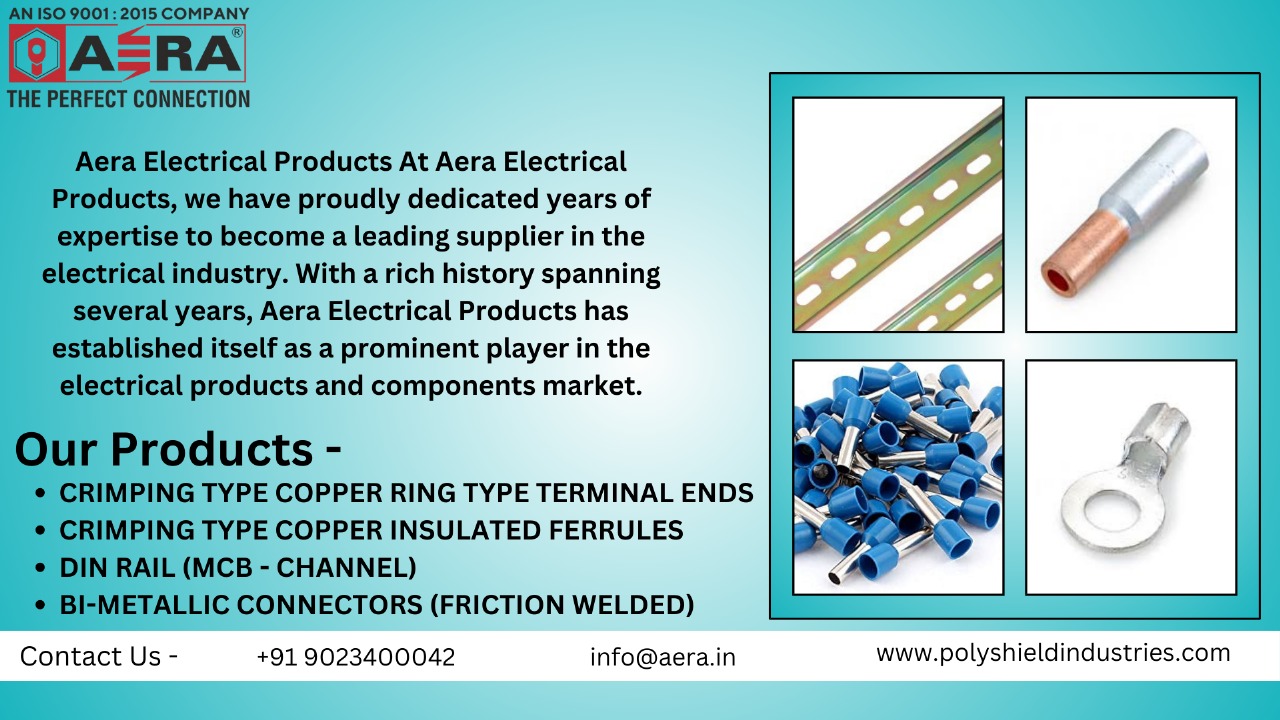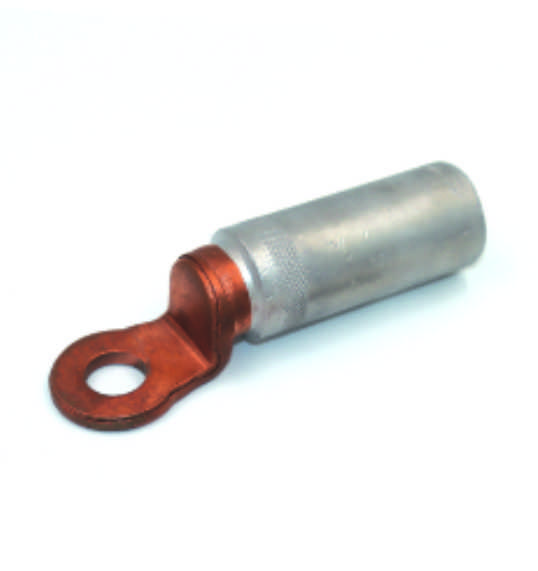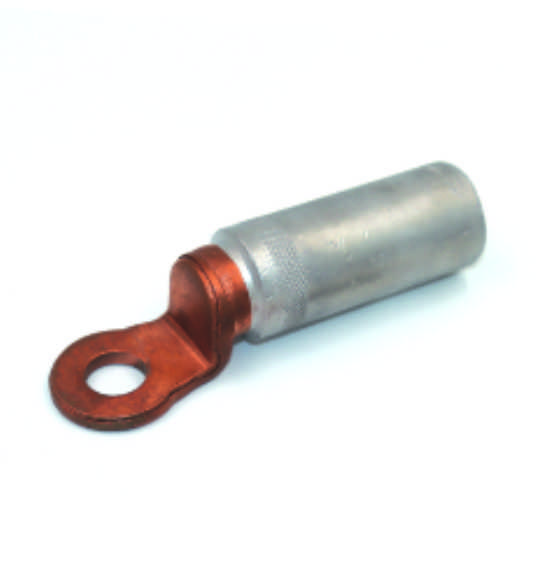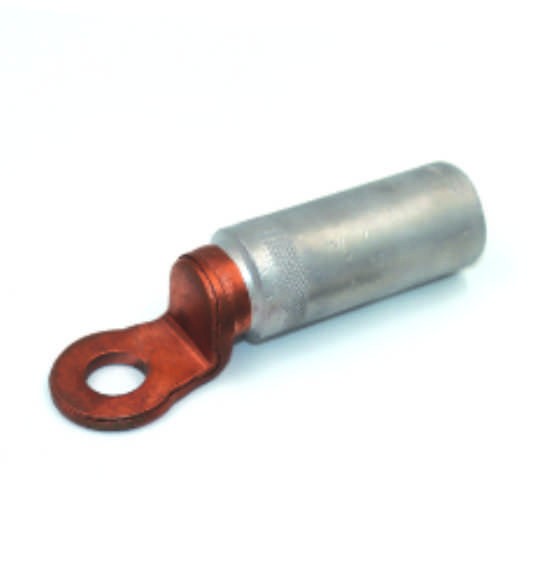
Crimping Type Aluminium Tubular Terminal Ends
Crimping Type Aluminium Tubular Terminal Ends
CrimpingType Aluminium Tubular Terminal Ends are electrical connectors used for terminating
aluminium conductors to ensure a secure and reliable mechanical and electrical
connection. These terminal ends are designed with a tubular barrel that
accommodates the aluminium cable and a flat palm or pad that can be bolted to
terminals, busbars, or lugs. Crimping is done using a hydraulic or mechanical
crimping tool, creating a cold-welded connection that minimizes resistance and
enhances conductivity. These terminals are widely used in power distribution, switchgear,
control panels, and electrical substations, particularly where aluminium cables
are preferred for cost and weight advantages.
10 Frequently Asked Questions (FAQs) of Crimping
Type Aluminium Tubular Terminal Ends
- What is the purpose of
aluminium tubular terminal ends?
To connect aluminium conductors securely to electrical devices or busbars by crimping. - How are these terminals
installed?
By inserting the stripped cable into the barrel and crimping it using an appropriate crimping tool. - Why use aluminium instead of
copper terminal ends?
Aluminium is lighter and more cost-effective, making it suitable for large-scale power distribution systems. - Can aluminium terminals be
used with copper cables?
No, they are specifically designed for aluminium conductors; using them with copper can cause galvanic corrosion. - Are these terminals suitable
for outdoor use?
Yes, provided they are properly sealed and protected with anti-oxidation compound and heat-shrink sleeves. - Do these terminals require
pre-treatment before crimping?
Yes, the aluminium conductor should be cleaned and anti-oxidation grease (like oxide inhibitor) applied. - What standards do these
terminals conform to?
Most follow standards such as DIN 46235, IEC 61238-1, or IS 8309. - What tools are used for
crimping?
Hydraulic or mechanical crimping tools with die sets matched to the terminal size. - What sizes are available for
these terminal ends?
They range from 16 mm² to over 1000 mm², depending on the application and manufacturer. - What is the difference
between crimping and soldering terminal ends?
Crimping provides a gas-tight, high-pressure mechanical connection; soldering involves heating and is less reliable for high-power applications.
Applications of Crimping Type Aluminium Tubular
Terminal Ends
- Power Distribution Panels
- High Voltage Switchgear
- Transformer Connections
- Industrial Control Cabinets
- Underground Cable Jointing
- Renewable Energy Systems (Solar/Wind)
- Electrical Substations
- Railway Electrification
- Building and Infrastructure
Wiring
- Marine and Shipboard
Installations
Benefits of Crimping Type Aluminium Tubular
Terminal Ends
- Reliable Electrical
Connection
Reduces contact resistance and improves performance.
- Lightweight Design Aluminium is lighter than
copper, reducing structural loads.
- Cost-Effective Aluminium terminals are generally
more affordable than copper alternatives.
- Corrosion Resistant (when
treated)
With anti-oxidation compound and sealing, they resist corrosion.
- Wide Range of Sizes Available for small to
very large conductor sizes.
- Quick Installation Fast and easy with
standard crimping tools.
- High Conductivity Ensures efficient power transfer.
- Mechanical Strength Strong bond when properly
crimped.
- Customizable Can be tinned,
color-coded, or insulated based on project needs.
- Compliance with Standards Ensures safety and
performance under regulated conditions.
Contact us more details :
Call - +91
9023400042, +919099918363
Email - info@aera.in
Address -
A-12,MAHADEV ESTATE-2,B/H RAMOL POLICE STATION CTM-RAMOL ROAD RAMOL
AHMEDABAD-382449.
Related Keywords
Quick Enquiry
Filter Using Product Tags
Crimping Type Copper Ring Terminal Ends| Copper Crimping Terminals| Ring Type Copper Terminal Ends| Copper Wire Crimp Terminals| Crimping Ring Terminals| Copper Crimp Terminals for Electrical Wiring| Ring Terminals for Copper Wire| Heavy Duty Copper Crimp Terminals| Copper Electrical Terminals| Copper Crimping Connector Terminals| Crimp Copper Terminals for Wire Connection| Copper Wire End Connectors| Industrial Crimping Terminals| Electrical Copper Ring Terminals| Copper Terminal Ends for Electrical Wire| Insulated Copper Ring Terminal Ends| Crimping Type Insulated Copper Terminals| Copper Insulated Crimp Terminals| Insulated Crimp Ring Terminals| Copper Ring Terminal Ends with Insulation| Electrical Insulated Crimp Terminals| Insulated Copper Electrical Terminals| Ring Type Insulated Copper Terminals| Insulated Copper Wire Crimp Terminals| Crimp Ring Terminals for Insulated Wires| Insulated Crimp Terminals for Electrical Wiring| Insulated Copper Terminals for Wire Connections| Insulated Crimp Copper Terminal Connectors| Ring Type Insulated Electrical Terminals| Insulated Copper Pin Terminal Ends| Crimping Copper Pin Type Terminals| Copper Pin Crimp Terminals (Insulated)| Insulated Copper Electrical Pin Terminals| Crimp Pin Terminals for Copper Wires| Copper Pin Type Terminal Ends with Insulation| Insulated Crimp Pin Connectors| Pin Type Crimp Terminals for Copper Wire| Insulated Copper Crimp Pin Connectors| Copper Pin Terminals for Electrical Wiring| Crimping Copper Pin Terminals (Insulated) for Wiring| Electrical Insulated Copper Pin Terminals| Insulated Copper Pin Connectors for Wiring| Heavy Duty Insulated Copper Pin Terminals| Insulated Crimp Pin Terminals for Electrical Connections| Copper Fork Terminal Ends| Crimping Type Copper Fork Terminals| Copper Fork Type Crimp Terminals| Crimp Fork Terminals for Copper Wire| Fork Type Copper Electrical Terminals| Copper Crimp Fork Terminal Connectors| Fork Crimp Terminals for Copper Wires| Copper Crimping Fork Terminals| High-Quality Copper Fork Terminals| Crimp Fork Connectors for Copper Wires| Copper Crimp Fork Terminals for Electrical Wiring| Heavy Duty Copper Fork Terminals| Fork Type Electrical Copper Terminals| Crimp Copper Fork Terminals for Wiring| Copper Fork Terminal Connectors for Electrical Applications| Insulated Copper Fork Terminal Ends| Crimping Copper Fork Terminals (Insulated)| Copper Fork Type Crimp Terminals (Insulated)| Insulated Copper Fork Terminals for Electrical Wiring| Fork Type Insulated Copper Crimp Terminals| Insulated Copper Fork Connectors| Electrical Insulated Copper Fork Terminals| Crimp Fork Terminals for Insulated Copper Wires| Insulated Fork Terminal Ends for Copper Wires| Heavy Duty Insulated Copper Fork Terminals| Copper Fork Crimp Terminals with Insulation| Fork Type Insulated Copper Electrical Terminals| Insulated Copper Fork Connectors for Wiring| Industrial Insulated Copper Fork Terminals| Insulated Copper Fork Terminals for Crimping| Copper Pin Terminal Ends| Crimping Type Copper Pin Terminals| Copper Pin Type Crimp Terminals| Pin Type Crimp Terminals for Copper Wire| Copper Crimp Pin Terminals| Crimp Pin Terminals for Copper Wires| Copper Pin End Terminals| Copper Electrical Pin Type Terminals| Heavy Duty Copper Pin Crimp Terminals| Pin Type Copper Electrical Terminals| Copper Pin Connectors for Crimping| High-Quality Copper Pin Terminals| Pin Type Crimp Connectors for Copper Wires| Copper Crimping Pin Terminals| Industrial Copper Pin Terminals for Crimping| Copper Insulated Ferrules| Crimping Copper Ferrules| Copper Insulated Crimp Ferrules| Insulated Copper Ferrules for Crimping| Crimp Copper Insulated Ferrules| Electrical Copper Ferrules (Insulated)| Copper Ferrules with Insulation| Insulated Ferrules for Copper Wires| Crimping Ferrules for Insulated Copper Wires| High-Quality Copper Insulated Ferrules| Insulated Copper Crimping Ferrule Connectors| Copper Crimp Ferrules with Insulation| Insulated Ferrules for Electrical Connections| Industrial Copper Insulated Ferrules| Copper Insulated Ferrules for Electrical Wiring| Copper Insulated Twin Cord Ferrules| Crimping Copper Twin Cord Ferrules| Insulated Twin Cord Ferrules for Copper Wires| Copper Twin Cord Crimp Ferrules| Crimp Copper Insulated Twin Ferrules| Twin Cord Copper Ferrules (Insulated)| Copper Insulated Ferrules for Twin Wires| Crimp Ferrules for Twin Copper Cords| Insulated Twin Cord Ferrules for Electrical Wiring| Copper Crimping Twin Cord Ferrules| Insulated Copper Twin Cord Ferrule Connectors| Electrical Twin Cord Copper Ferrules (Insulated)| High-Quality Copper Insulated Twin Ferrules| Copper Ferrules for Twin Wire Connections| Crimp Ferrules for Copper Twin Cord Wires| Copper Tubular Terminal Ends| Crimping Copper Tubular Terminals| Copper Tubular Crimp Terminals| Crimp Copper Tubular Terminal Connectors| Electrical Copper Tubular Terminals| Copper Tubular Crimping Terminals| Crimping Type Copper Terminals| Copper Tubular Connectors for Crimping| Industrial Copper Tubular Terminals| High-Quality Copper Tubular Terminal Ends| Copper Tubular Crimp Terminal Connectors| Heavy Duty Copper Tubular Crimp Terminals| Copper Crimping Tubular Terminals for Electrical Wiring| Tubular Copper Terminals for Crimping| Copper Tubular End Connectors| Copper In-Line Crimp Connectors| Crimping Type Copper Connectors| Copper In-Line Connectors for Crimping| Electrical Copper In-Line Crimp Connectors| Crimping Copper In-Line Connectors for Wiring| Copper In-Line Crimp Terminal Connectors| High-Quality Copper In-Line Connectors| Copper Crimp In-Line Connectors for Electrical Applications| In-Line Crimp Connectors for Copper Wires| Copper In-Line Wire Crimp Connectors| Industrial Copper In-Line Connectors| Crimping Connectors for Copper Wires (In-Line)| Copper In-Line Crimping Connectors for Electrical Connections| Copper Crimp Connectors for In-Line Wire Terminations| Best Copper In-Line Crimp Connectors for Wiring| Copper Tubular Terminal Ends (Long Barrel)| Long Barrel Copper Tubular Crimp Terminals| Crimping Copper Long Barrel Terminals| Copper Long Barrel Terminal Ends for Crimping| Long Barrel Copper Crimp Terminals| Copper Tubular Crimp Terminals (Long Barrel)| Electrical Copper Long Barrel Terminals| Long Barrel Crimp Connectors for Copper Wires| Heavy Duty Copper Tubular Terminal Ends (Long Barrel)| Copper Long Barrel Crimp Terminals for Electrical Wiring| Crimping Type Copper Tubular Terminals (Long Barrel)| Long Barrel Copper Crimping Connectors| Industrial Copper Tubular Terminals (Long Barrel)| Copper Crimping Long Barrel Terminal Ends| High-Quality Copper Long Barrel Crimp Terminals| Copper End Sealing Ferrules| Crimping Copper Ferrules| Copper End Sealing Ferrules for Wires| Crimping End Sealing Copper Ferrules| Copper Ferrules for End Sealing| End Sealing Copper Crimp Ferrules| Copper Ferrules with End Seal for Crimping| Crimp Copper End Sealing Ferrules| Electrical Copper End Sealing Ferrules| Copper Ferrules for Wire End Sealing| End Sealing Ferrules for Copper Wires| High-Quality Copper End Sealing Ferrules| Crimping Ferrules with Copper End Seal| Industrial Copper End Sealing Ferrules| Copper Crimp Ferrules for End Sealing| Heavy Duty Copper Tubular Terminal Ends| Crimping Type Heavy Duty Copper Terminals| Heavy Duty Copper Tubular Crimp Terminals| Copper Heavy Duty Crimp Terminal Ends| Heavy Duty Copper Crimp Terminal Connectors| Crimping Copper Tubular Terminals for Heavy Duty Use| Copper Heavy Duty Terminal Ends for Crimping| Industrial Copper Tubular Terminal Ends (Heavy Duty)| High-Quality Heavy Duty Copper Tubular Terminals| Copper Crimp Terminals for Heavy Duty Applications| Copper Tubular Crimp Terminals (Heavy Duty) for Wiring| Heavy Duty Copper Crimping Terminal Connectors| Durable Copper Tubular Terminal Ends (Heavy Duty)| Heavy Duty Copper Terminal Ends for Electrical Wiring| Copper Tubular Crimp Connectors (Heavy Duty)| Heavy Duty Copper In-Line Connectors| Crimping Type Heavy Duty Copper Connectors| Heavy Duty Copper In-Line Crimp Connectors| Crimp Copper In-Line Connectors (Heavy Duty)| Copper In-Line Connectors for Heavy Duty Applications| Heavy Duty Copper Electrical In-Line Connectors| Copper In-Line Crimp Connectors for Heavy Duty Use| Industrial Heavy Duty Copper In-Line Connectors| High-Quality Heavy Duty Copper In-Line Connectors| Copper Crimp In-Line Connectors for Heavy Duty Wiring| Heavy Duty Copper In-Line Wire Connectors| Copper In-Line Crimp Connectors for Industrial Use| Durable Heavy Duty Copper In-Line Connectors| Crimping Connectors for Heavy Duty Copper Wires| Copper Heavy Duty In-Line Crimping Connectors| Copper Long Palm Two Hole Terminal Ends| Crimping Type Copper Two Hole Tubular Terminals| Copper Long Palm Crimp Terminals| Two Hole Copper Tubular Terminal Ends| Copper Two Hole Tubular Crimp Terminals| Copper Two Hole Long Palm Terminal Connectors| Crimping Copper Two Hole Terminal Ends| Heavy Duty Copper Long Palm Terminal Ends| Copper Long Palm Crimping Terminals for Wiring| Industrial Copper Two Hole Tubular Terminals| Copper Tubular Terminals (Two Hole) for Crimping| Long Palm Copper Crimp Terminals with Two Holes| Two Hole Tubular Copper Terminals for Electrical Applications| Crimp Type Copper Long Palm Two Hole Terminal Connectors| Two Hole Copper Crimping Terminals for Electrical Wiring| Copper Four Hole Tubular Terminal Ends| Crimping Type Copper Four Hole Terminals| Copper Four Hole Crimp Terminals| Four Hole Copper Tubular Crimp Terminals| Copper Four Hole Terminal Connectors| Crimping Copper Four Hole Tubular Terminals| Heavy Duty Copper Four Hole Terminal Ends| Copper Four Hole Crimping Terminals for Wiring| Copper Four Hole Tubular Terminals for Electrical Connections| Industrial Copper Four Hole Crimp Terminals| Copper Four Hole Terminal Ends for Electrical Wiring| High-Quality Copper Four Hole Crimp Terminals| Four Hole Copper Tubular Terminals for Crimping| Copper Four Hole Crimp Connectors for Electrical Systems| Durable Copper Four Hole Terminal Ends| Aluminium Tubular Terminal Ends| Crimping Type Aluminium Terminal Ends| Aluminium Tubular Crimp Terminals| Crimp Aluminium Tubular Terminals| Aluminium Crimp Terminals for Wiring| Industrial Aluminium Tubular Terminals| Crimping Aluminium Terminal Connectors| High-Quality Aluminium Tubular Crimp Terminals| Aluminium Tubular Crimp Connectors for Electrical Wiring| Aluminium Crimping Tubular Terminals for Electrical Applications| Aluminium Crimp Tubular Terminals for Heavy Duty| Crimping Aluminium Tubular Terminals for Industrial Use| Copper and Aluminium Crimp Tubular Terminal Ends| Aluminium Tubular Terminals for Electrical Connections| Durable Aluminium Crimp Terminals for Wiring| Aluminium Tubular Terminal Ends (Long Barrel)| Crimping Aluminium Long Barrel Terminal Ends| Aluminium Long Barrel Crimp Terminals| Long Barrel Aluminium Tubular Terminals| Crimp Aluminium Long Barrel Tubular Terminals| Industrial Aluminium Long Barrel Terminals| Aluminium Crimp Terminals with Long Barrel| Long Barrel Aluminium Crimping Terminals| High-Quality Aluminium Long Barrel Terminal Ends| Crimping Aluminium Long Barrel Connectors| Long Barrel Aluminium Crimp Connectors| Heavy Duty Aluminium Tubular Terminals (Long Barrel)| Aluminium Long Barrel Crimping Terminal Connectors| Long Barrel Aluminium Terminals for Crimping| Aluminium Tubular Long Barrel Terminals for Electrical Wiring| Aluminium In-Line Connectors| Crimping Type Aluminium Connectors| Aluminium In-Line Crimp Connectors| Crimp Aluminium In-Line Connectors| Aluminium Crimp Connectors for In-Line Applications| In-Line Crimping Aluminium Connectors| High-Quality Aluminium In-Line Connectors| Industrial Aluminium In-Line Crimp Connectors| Aluminium Crimp In-Line Terminal Connectors| Crimping In-Line Aluminium Connectors for Electrical Wiring| Durable Aluminium In-Line Crimp Connectors| Aluminium In-Line Wire Connectors| Heavy Duty Aluminium In-Line Crimp Connectors| Affordable Aluminium In-Line Crimp Connectors for Wiring| Aluminium Crimp In-Line Connectors for Industrial Use| Aluminium Reducer Type Terminal Ends| Crimping Aluminium Reducer Terminals| Aluminium Reducer Crimp Terminals| Crimp Type Aluminium Reducer Connectors| Aluminium Reducer Terminals for Crimping| Aluminium Crimp Reducer Terminal Ends| Aluminium Terminal Ends (Reducer Type)| Heavy Duty Aluminium Reducer Terminal Ends| Crimping Aluminium Reducer Connectors for Wiring| Industrial Aluminium Reducer Crimp Terminals| Aluminium Crimp Reducer Connectors for Electrical Applications| High-Quality Aluminium Reducer Crimp Terminals| Aluminium Crimp Terminals for Reduced Connections| Durable Aluminium Reducer Type Terminals| Aluminium Crimp Reducer Type Terminals for Industrial Use| DIN Rail C-Channel| C-Channel DIN Rail Mounting| DIN Rail for Electrical Installations| C-Channel DIN Rail for Panel Mounting| Industrial C-Channel DIN Rail| DIN Rail C-Channel for Electrical Equipment| Heavy Duty C-Channel DIN Rail| Best DIN Rail C-Channel for Wiring| C-Channel DIN Rails for Electrical Systems| High-Quality C-Channel DIN Rail| DIN Rail C-Channel for Industrial Use| Durable C-Channel DIN Rails| C-Channel DIN Rail for Automation Panels| C-Channel DIN Rail for Electrical Panel Mounting| Electrical C-Channel DIN Rails| Snap-On Type Terminal Ends| Snap-On Electrical Terminal Ends| Snap-On Crimp Terminal Connectors| Snap-On Type Terminals for Electrical Wiring| Snap-On Terminal Ends for Crimping| Snap-On Wire Connectors| Snap-On Connectors for Electrical Terminals| High-Quality Snap-On Terminal Ends| Snap-On Type Terminals for Electrical Systems| Snap-On Electrical Crimp Terminals| Snap-On Terminals for Industrial Use| Snap-On Type Terminal Connectors for Wiring| Durable Snap-On Electrical Terminals| Snap-On Connectors for High-Voltage Wiring| Snap-On Terminal Ends for Quick Connections| Copper Tubular Terminal Ends for XLPE Cable| Crimping Copper Terminal Ends for XLPE Wires| Copper Tubular Crimp Terminals for XLPE Cable| XLPE Cable Crimping Copper Terminal Connectors| Copper Tubular Crimp Terminals for XLPE Cable Wiring| Crimp Type Copper Terminal Ends for XLPE Insulated Cable| Copper Crimp Terminals for XLPE Cable Applications| XLPE Cable Crimping Terminal Connectors| High-Quality Copper Tubular Terminals for XLPE Cables| Copper Tubular Crimp Connectors for XLPE Electrical Cable| Durable Copper Crimping Terminal Ends for XLPE Cable| Copper XLPE Cable Crimp Terminal Connectors| Industrial Copper Tubular Terminals for XLPE Cable| Crimp Type Copper XLPE Cable Terminals| XLPE Cable Crimping Copper Tubular Terminals for Electrical Wiring| Copper Reducer Type Terminal Ends| Crimping Copper Reducer Terminals| Copper Reducer Crimp Terminals| Crimp Type Copper Reducer Connectors| Copper Crimp Reducer Terminal Ends| Copper Reducer Crimp Connectors| Copper Reducer Type Crimping Terminals| Industrial Copper Reducer Terminal Ends| High-Quality Copper Reducer Crimp Terminals| Copper Crimping Reducer Terminal Connectors| Durable Copper Reducer Type Crimp Terminals| Copper Reducer Type Terminals for Electrical Systems| Copper Crimp Connectors with Reducer Type Terminals| Best Copper Reducer Type Terminal Ends for Wiring| Copper Crimp Terminals for Reduced Wiring Connections| Bi-Metallic Connectors Friction Welded| Friction Welded Bi-Metallic Connectors| Bi-Metallic Friction Welded Connectors for Electrical Systems| High-Quality Bi-Metallic Connectors (Friction Welded)| Friction Welded Bi-Metallic Cable Connectors| Bi-Metallic Connectors for Electrical Wiring (Friction Welded)| Friction Welded Bi-Metallic Connectors for Power Transmission| Industrial Bi-Metallic Connectors (Friction Welded)| Bi-Metallic Connectors with Friction Welding Technology| Friction Welded Bi-Metallic Electrical Connectors| Best Bi-Metallic Connectors for Electrical Systems (Friction Welded)| Durable Friction Welded Bi-Metallic Connectors| Bi-Metallic Friction Welded Connectors for Heavy Duty| Bi-Metallic Connectors for High Voltage (Friction Welded)| Affordable Bi-Metallic Friction Welded Connectors| Bi-Metallic Terminals Friction Welded| Friction Welded Bi-Metallic Terminals| Bi-Metallic Electrical Terminals (Friction Welded)| Friction Welded Bi-Metallic Cable Terminals| High-Quality Bi-Metallic Terminals (Friction Welded)| Bi-Metallic Terminals for Electrical Wiring (Friction Welded)| Friction Welded Terminals for Bi-Metallic Cables| Industrial Bi-Metallic Terminals (Friction Welded)| Durable Bi-Metallic Friction Welded Terminals| Bi-Metallic Cable Terminals (Friction Welded) for Power Systems| Best Bi-Metallic Terminals for Electrical Applications (Friction Welded)| Friction Welded Bi-Metallic Cable Joining Terminals| Bi-Metallic Power Cable Terminals (Friction Welded)| Friction Welded Bi-Metallic Terminals for Heavy Duty Applications| Bi-Metallic Electrical Terminals with Friction Welding Technology| DIN Rail MCB Channel| MCB DIN Rail Mounting Channel| DIN Rail for MCB Circuit Breakers| MCB Channel DIN Rail for Electrical Panels| DIN Rail for MCB Installation| MCB Mounting Channel for DIN Rail| High-Quality DIN Rail MCB Channel| MCB DIN Rail for Electrical Systems| MCB Channel for DIN Rail Mounting| Durable DIN Rail MCB Channel| DIN Rail for MCB Circuit Breaker Panel| MCB Mounting Rail (DIN Standard)| Affordable DIN Rail MCB Channel for Panels| MCB DIN Rail for Industrial Electrical Use| Standard DIN Rail for MCB Circuit Breakers|



Our Products
Popular Links
Get In Touch
A-12,MAHADEV ESTATE-2,B/H RAMOL POLICE STATION CTM-RAMOL ROAD RAMOL AHMEDABAD-382449
info@aera.in
+91 9023400042
+919099918363
© Aera Electrical Products . All Rights Reserved.
Designed by industrieslead.com



